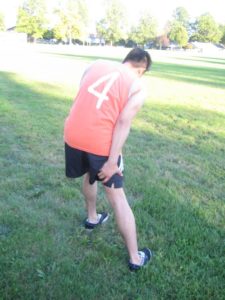A thigh strain involves a tear in one of the quadriceps muscles at the anterior region of the thigh. The injury can range from minimal discomfort to a full-blown tear that results to intense pain and inability to walk.
A tear to the quadriceps muscles generally manifest after some activities such as jumping, kicking or sprinting especially if correct warm-up is not done. Remember that any of these muscles might tear but the rectus femoris is typically damaged.
What are the indications?
The indications of a thigh strain generally include an abrupt sharp pain in front of the thigh. The injury is categorized into different grades based on its severity.
- Grade 1 – a twinge or mild discomfort can be felt in the thigh along with a generalized feeling of tightness. There is minimal discomfort while walking and running can be hard. In addition, there is a lump or site of spasm.
Ice must be applied during the initial 72 hours after the injury. - Grade 2 – there is an abrupt sharp pain while jumping, running or kicking. The pain makes it hard to walk and there is swelling and mild bruising. There is pain felt when the site of injury is pressed. If the knee is straightened against resistance, it will trigger pain. In addition, the individual could not fully flex the knee.
- Grade 3 – there is severe, abrupt pain in the front part of the thigh. The individual has difficulty walking without the aid of crutches. Serious swelling arises right away along with evident bruising within 24 hours. Static muscular contraction can be painful and likely to generate a lump in the muscle.
Management of a thigh strain
The primary mode of treatment for a thigh strain is to utilize the PRICE method.
- Protect the damaged muscle with a compression bandage or thigh support.
- Rest from any physical activity or sports during the initial phases of healing. If the individual continues to train with the damaged muscle, proper healing can be prevented. Raising the affected limb must be done during the initial stages and ideally accomplished by lying on a sofa with the leg positioned on top of 2 cushions or pillows.
- Ice must be applied during the initial 72 hours after the injury. The ice pack must be applied for 10 minutes at each hour and steadily reduced as the symptoms settle. The cold helps control the internal bleeding and swelling.
- Compression helps lessen the swelling as well as protect the site of injury.
- Elevation of the damaged leg can ease the swelling and allow the drainage of fluid away from the site of the injury.
Disclaimer / More Information
The information posted on this page on a thigh strain is for learning and educational purposes only. To learn how it is properly managed, register for first aid training at one of our training centers located throughout Canada. The training centers are in Edmonton, Calgary, Vancouver, Kelowna, Saskatoon, Victoria, Surrey, Mississauga, Winnipeg, Red Deer, Toronto, Ottawa and Halifax.

